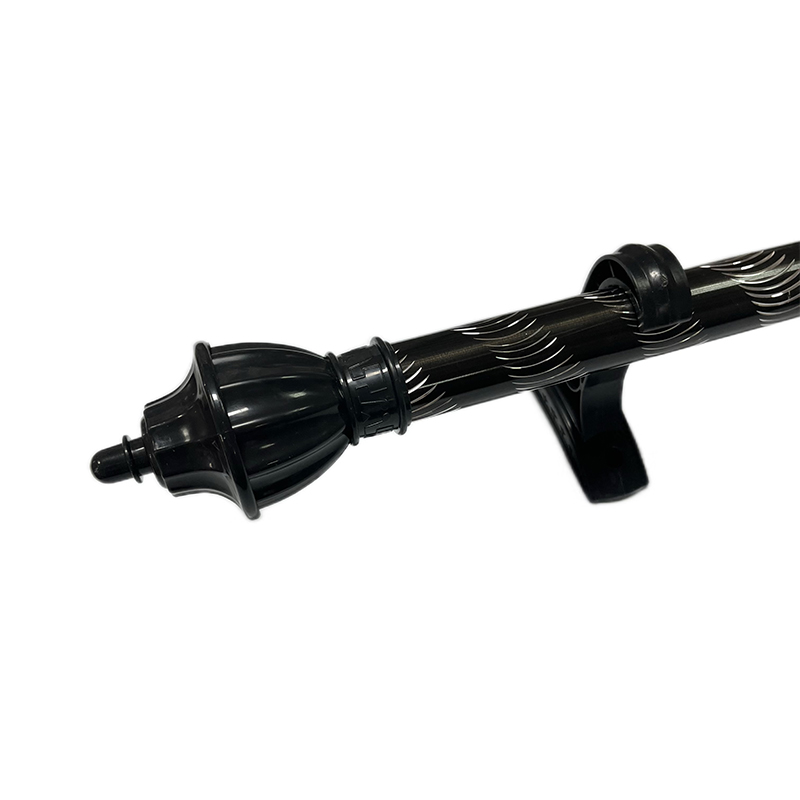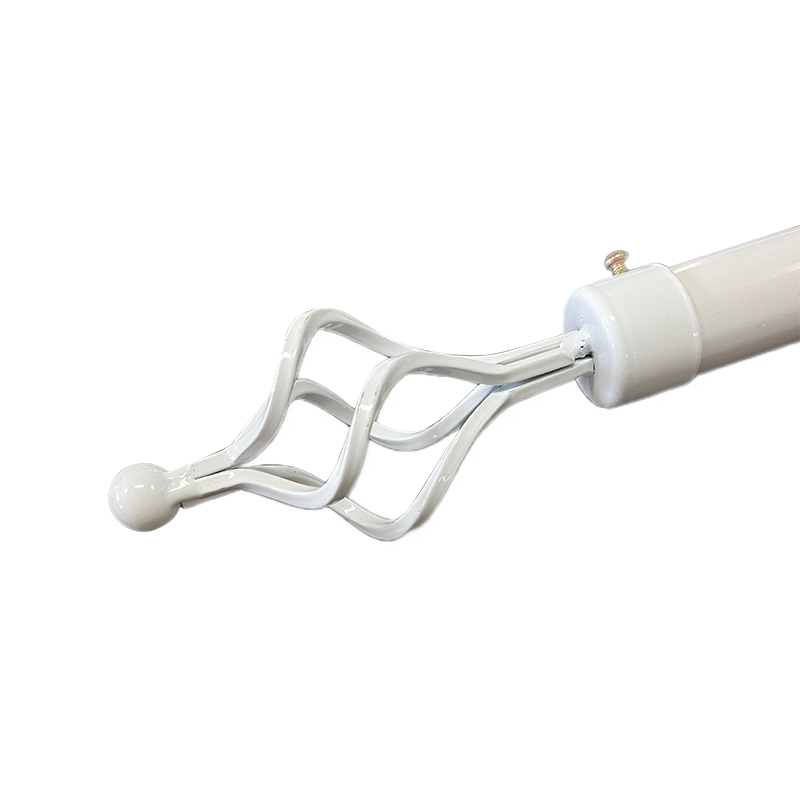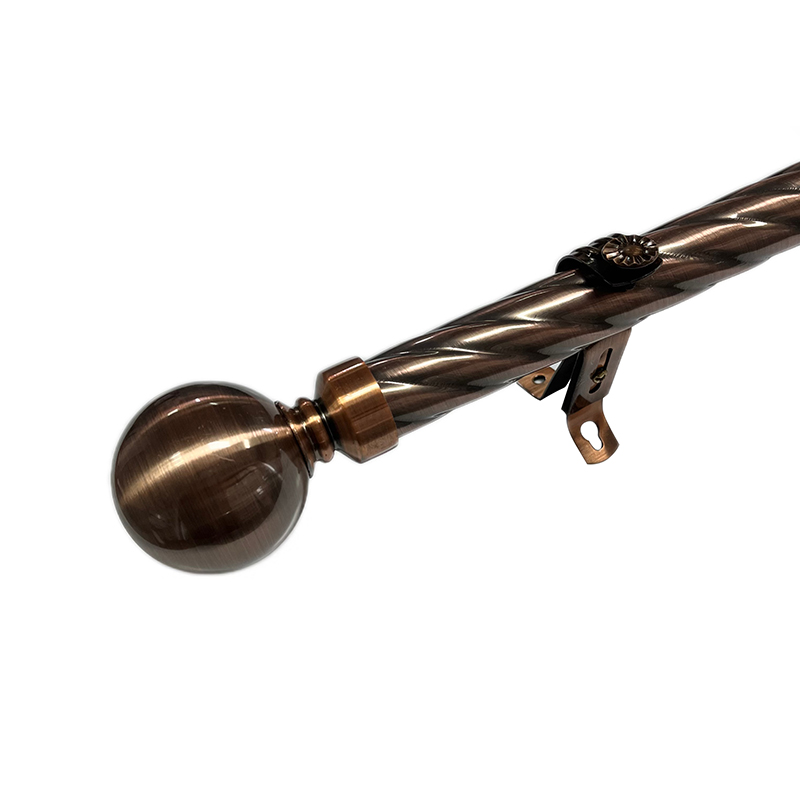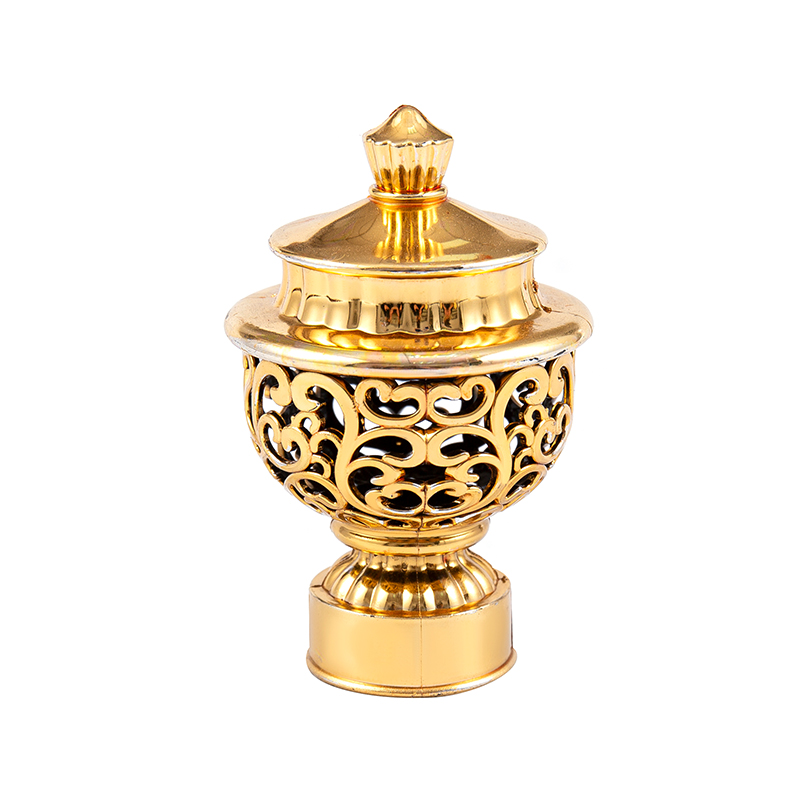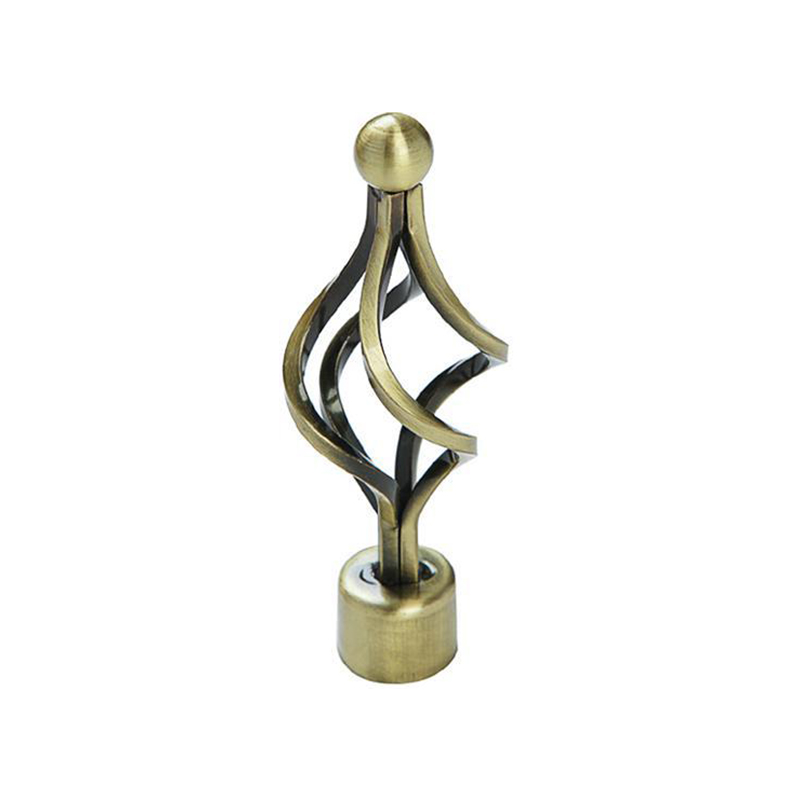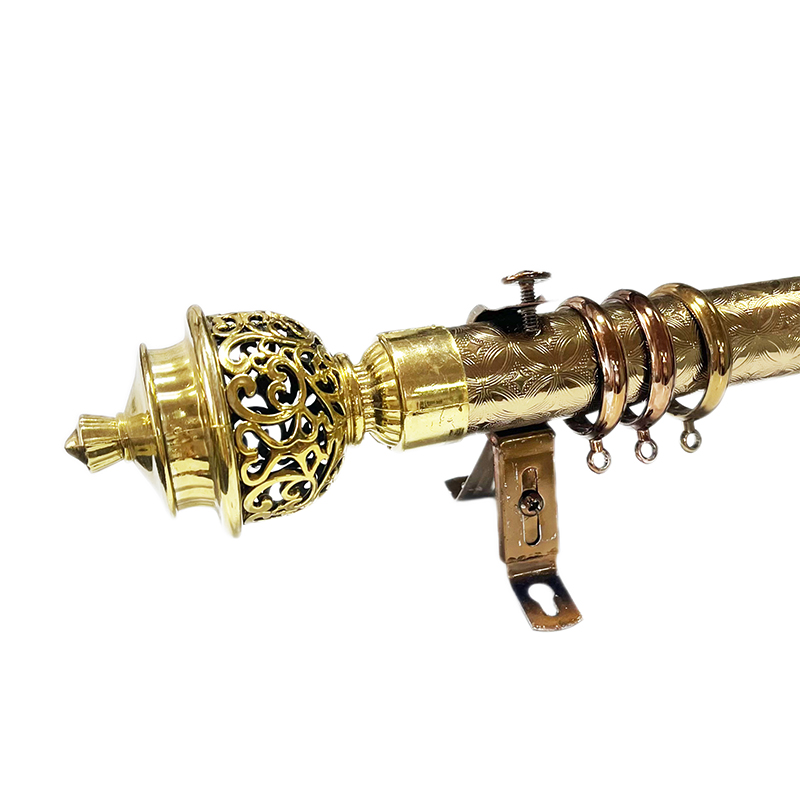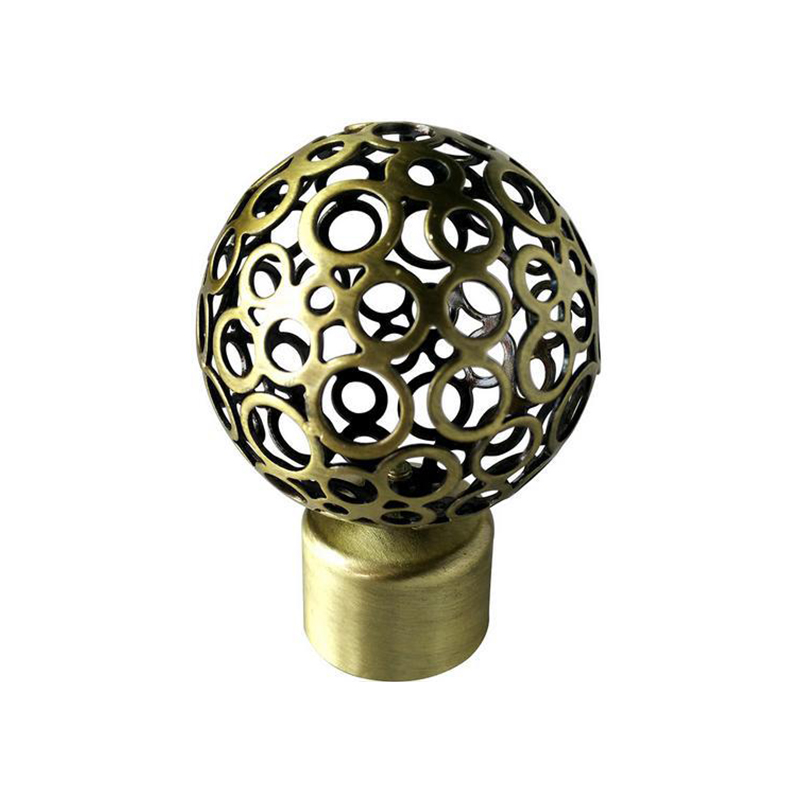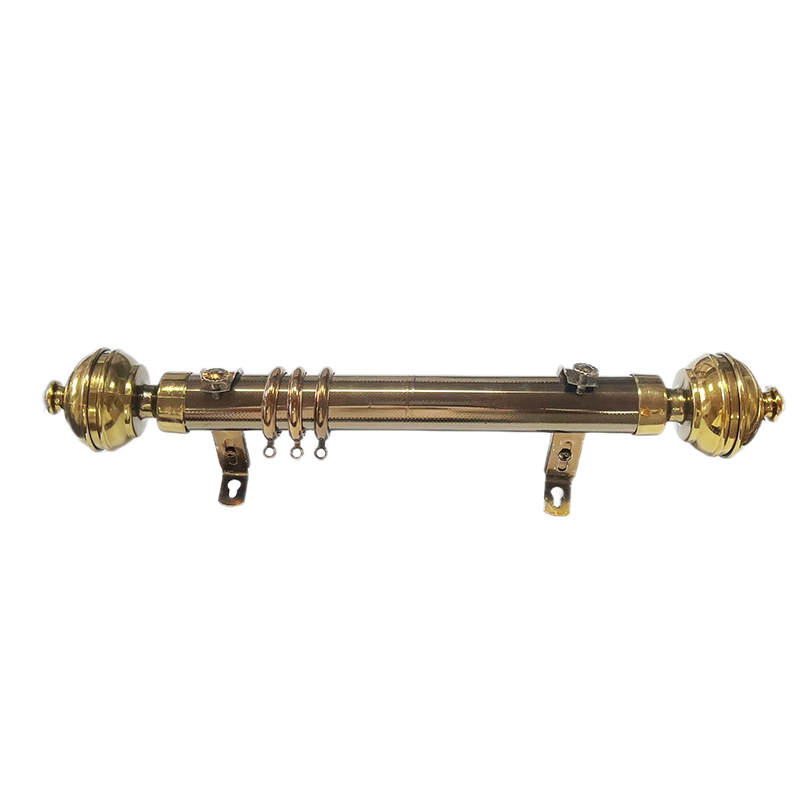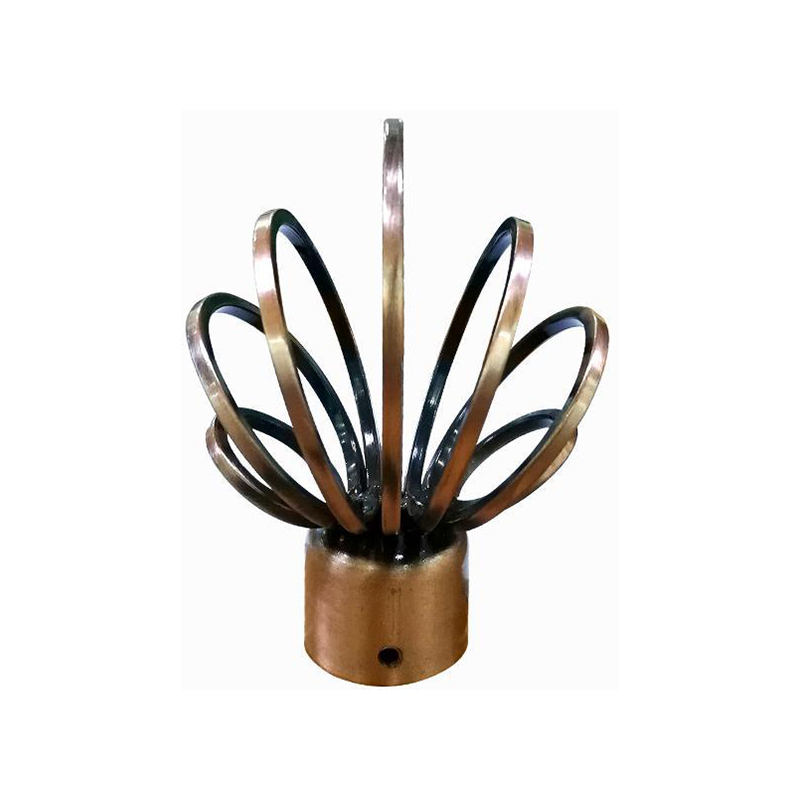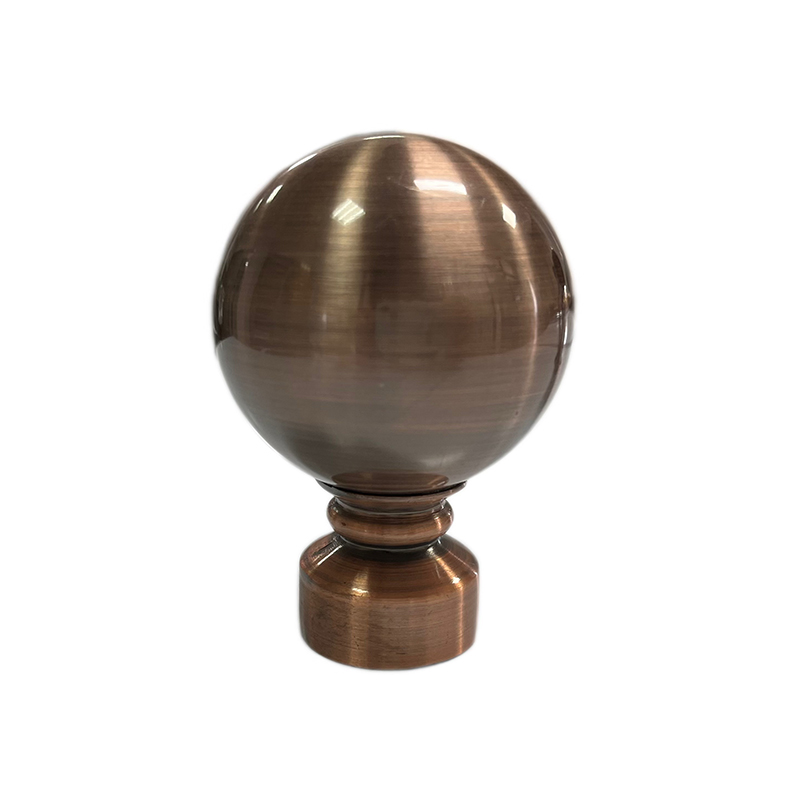Understand the basic structure and use of curtain rods
Definition and basic functions of curtain rods
A curtain rod is a supporting device installed above the window for hanging curtains. Its basic function is to bear the weight of the curtain fabric so that it can be hung stably and run smoothly when opening and closing. Curtain rods can achieve functions such as pushing and pulling, shading and decoration of curtains by cooperating with hooks, pulleys or rings. At the same time, the curtain rod itself is also an important part of interior soft furnishings, which can be coordinated with the overall home style and enhance the layering and integrity of the space.
Main components of curtain rods
The curtain rod consists of multiple structures, each of which plays a specific role during use. It usually includes a rod body, a bracket, end cap ornaments and curtain accessories. The rod body is the core structure of the curtain rod and bears the weight of the entire curtain; the bracket is used to fix the rod body to the wall or ceiling to ensure stability; the end cap ornaments are located at both ends of the rod body, which not only has a visual decorative effect, but also prevents the curtain from sliding off from both ends; and curtain accessories such as hanging rings, hooks, pulleys, etc. directly affect the hanging method and opening smoothness of the curtain. These components work together to enable curtain rods to meet diverse installation and use needs.
The impact of material type on curtain rod performance
Common materials for curtain rods include metal, wood and plastic, each of which has its own characteristics. Metal curtain rods are generally made of aluminum alloy or stainless steel, which has the characteristics of compact structure and strong support, and is suitable for hanging heavy curtains. Wooden curtain rods are favored for their natural texture and are often used in American, country or retro style interior decoration. Plastic curtain rods are characterized by lightness and easy installation, and are suitable for use in humid environments such as kitchens and bathrooms or light curtains. Material selection should be considered in combination with curtain weight, room style and frequency of use.
Curtain rod installation method and applicable scenarios
The installation methods of curtain rods mainly include wall installation and ceiling installation. Wall installation is to install the curtain rod on the wall above the window, which is suitable for most residential and commercial spaces and is relatively easy to install. Ceiling installation is to install the curtain rod on the ceiling, which is suitable for scenes with low floor height or high window position, which can enhance the sense of space extension and visual height. When choosing the installation method, you also need to consider the wall material, load-bearing capacity and adaptability of the installation tools to ensure stability and safety after installation.
Structural characteristics and application advantages of retractable curtain rods
Retractable curtain rods can adjust their length through nested structures, making it easy to adapt to windows of different widths. This design avoids the problem of re-cutting or replacement due to size mismatch and improves installation flexibility. Structurally, retractable curtain rods are generally made of two or three sections of metal tubes, and the length is fixed with internal coil springs or buckle devices. In home use, it is especially suitable for users who rent houses, temporary arrangements or need to frequently change the space pattern, and has certain practicality and economy.
Structural differences between exposed and hidden curtain rods
Curtain rods can be divided into two types: exposed and hidden, depending on whether they are visible after installation. The exposed curtain rod has a clear structure and obvious end decoration. The rod body is often matched with hanging rings or hooks, and visually becomes part of the space decoration. Hidden curtain rods are usually installed in curtain boxes or ceilings. The rod body is blocked and not easy to be noticed, and more attention is paid to simple and unified visual effects. These two types of structures have their own advantages. When choosing, you should combine the space style, ceiling structure and curtain type to decide.
Function and design considerations of curtain rod end decorations
The ends of curtain rods are usually equipped with decorative end decorations, such as spherical, cylindrical, leaf-shaped and other shapes, which are not only decorative but also functional. Structurally, the end decorations can prevent the curtains from sliding off the sides of the rod when pulled, enhancing the safety of the use process. At the design level, the end shape often echoes the style of interior soft furnishings. For example, simple modern style often uses geometric shapes, while European style tends to have complex carved shapes. Consumers should take into account both aesthetics and functions when choosing to ensure the consistency of overall visual and use effects.
The relationship between curtain hanging methods and curtain rod structure
The curtain hanging methods put forward different requirements for the structure of curtain rods. Common curtain hanging methods include rod-through type, ring-hanging type, pulley track type, etc. The rod-through type is suitable for exposed rods, and there is a channel for inserting the rod body at the top of the curtain; the ring-hanging type uses metal or plastic rings to connect the curtains to the rod body, which is suitable for a variety of fabrics and designs; the pulley track type is usually matched with hidden curtain rods, which is smooth to operate and suitable for wide windows. Choosing a matching curtain rod structure according to different hanging methods can help improve the user experience and the drape of the curtain fabric.
Criteria for judging the load-bearing capacity of curtain rods
The load-bearing capacity of curtain rods directly affects their service life and safety. To determine whether a curtain rod is suitable for a certain curtain, it is necessary to comprehensively consider the rod material, diameter, bracket spacing and wall strength. Generally speaking, rods with thicker diameters and denser materials have higher load-bearing capacity, and the number and distribution of brackets play a key role in sharing the weight. For heavy curtains or multi-layer combination curtains, metal rods with stable structures and firm installations should be given priority, and a sufficient number of brackets should be configured to prevent the rod from bending or falling off.
Structural adaptability of curtain rods in different spaces
The structural design of curtain rods should be selected in combination with different spatial functions. For example, in the living room, exposed metal curtain rods with large diameter, prominent end shape and high load-bearing capacity are usually selected to reflect the openness and decorativeness of the space; the bedroom pays more attention to shading and privacy, and hidden curtain rods or curtain rods with sliding rails are more suitable; kitchens and bathrooms are more humid, so it is recommended to use moisture-proof and rust-proof plastic or coated metal materials. Different spaces have different requirements for aesthetics, durability and structural stability, and should be flexibly configured according to specific circumstances.
Coordination principle of curtain rod structure and interior style
As an important component connecting the wall and curtains in soft furnishings, the structure and shape of the curtain rod have a coordinating effect on the overall home decoration style. Simple modern style prefers thin lines, no end or minimalist decoration rods; Nordic style prefers natural wood curtain rods, matched with log furniture; European style often has carved or metal rods with strong texture to create a stable atmosphere. In the actual purchase process, the overall space style should be the main line to ensure that the curtain rod forms a harmonious and unified visual effect with the wall, curtains and furniture at the visual level.
Suggestions on the use and structural maintenance of curtain rods
In order to extend the service life of curtain rods, care should be taken to avoid frequent and violent pulling of curtains during daily use, especially for light plastic rods. During installation, ensure that the bracket is firmly fixed to avoid loosening or sinking of the rod due to uneven force. For metal curtain rods, wipe the surface regularly to keep it clean and avoid oxidation; wooden rods should avoid humid environments that affect structural stability. Proper structural maintenance not only improves the practicality of curtain rods, but also helps to keep the overall space clean and beautiful.
How to choose the right type of curtain rod according to the curtain style?
Understand the basic classification of curtain styles
Before choosing the type of curtain rod, you must first understand the basic classification of curtain styles. Common curtain styles include hanging rings, rod-through, perforated, rail-through and Roman blinds. Each curtain style has its own characteristics in terms of structure, hanging method and aesthetics. For example, hanging ring curtains need to be used with the ring buckle on the curtain rod; rod-through curtains directly pass the rod body through the sleeve designed at the top of the curtain. Different curtain structures have different requirements for the style, diameter, function and installation method of the curtain rod, so understanding the curtain style is the first step to correctly choose the curtain rod.
Hanging ring curtains are suitable for decorative exposed rods
Hanging ring curtains are a more traditional but still widely used curtain style. They fix the curtains to the rod body through metal or plastic rings. Because the buckle structure itself has a certain visual decorativeness, it is more suitable for exposed curtain rods. This type of curtain rod is commonly found in living rooms, study rooms or public spaces. Metal or wooden rods with end decorations can be selected to enhance the overall sense of hierarchy in the space. In terms of function, the exposed curtain rod with sliding hanging ring can make the curtain open and close more smoothly, especially suitable for wider windows or spaces that need to be opened frequently.
Rod-through curtains are more suitable for simple straight rod structures
Rod-through curtains set a channel at the top of the curtain, and the curtain rod needs to pass through the entire curtain to make the curtain hang naturally. This style is suitable for light fabrics and small space decoration, and its characteristics are simple structure and easy operation. Curtain rods suitable for rod-through curtains do not need to be equipped with accessories such as hanging rings. Generally, metal rods or wooden rods with moderate diameter and smooth surface are selected. The rod-through structure makes the curtains fit the rod body more closely as a whole, which is suitable for spaces that require privacy such as bedrooms or children's rooms. In order to ensure smooth sliding, the surface of the rod body needs to be smooth and the connection is stable.
Perforated curtains are suitable for thick diameter rod bodies
Punch curtains reserve metal eyelets above the curtains, and are hung by directly penetrating the rod body to form neat and natural folds. This style has high requirements for the diameter and structure of the rod body. Generally, metal curtain rods with thicker diameter and sturdy rod body are selected to bear the weight of the fabric and maintain balance. The visual effect of perforated curtains is neat and tidy, which is more in line with the modern minimalist style. The applicable curtain rod needs to have sufficient length and bracket support to avoid bending or sagging due to uneven weight of the curtain.
Sliding rail curtains are more compatible with hidden tracks
Sliding rail curtains are usually used in conjunction with track structures. The curtains are connected to the track through pulleys to achieve smooth opening and closing. This structure is mostly used in hotels, conference rooms or modern home environments that pursue a minimalist style. Unlike traditional rods, sliding rail curtains are more suitable for hidden curtain rods or ceiling embedded tracks. The track is generally made of aluminum alloy or high-strength plastic, and the built-in pulley can withstand greater tension and keep running quietly. This type of curtain rod has high requirements for installation accuracy in structure, but it is more integrated visually and is suitable for space design that requires neat lines.
The structure of Roman blinds needs to be matched with a special curtain rod system
Roman blinds are a type of curtain style that folds the curtains upward layer by layer through a pull cord system. Its structure is quite different from other curtain forms and needs to be matched with a special curtain rod system. Roman blind rods usually have a built-in lifting mechanism and are equipped with a guide device to achieve smooth lifting and lowering movements. The material is mainly aluminum alloy, which is light and has a certain strength. Since the installation of Roman blinds requires high accuracy, the curtain rod must be firmly fixed, and the pull cord system must also be equipped with a safety brake to ensure stability and safety during use.
Double-layer curtains need to consider multi-track structure design
For spaces designed with double-layer curtains (such as gauze curtains + thick curtains), the curtain rod needs to support a double-track or double-rod structure to hang two layers of curtains of different materials separately. Common designs include upper and lower double-layer slide rails, front and rear double-tube curtain rods and other structures. The double-track structure helps to achieve flexible switching between shading and light transmission, while keeping the curtains neatly hung. The curtain rod needs to have sufficient strength, and the bracket position should be reasonably set to avoid instability or falling off when the curtains overlap. In terms of material selection, aluminum alloy or steel rods are mainly used, which are more suitable for bearing the weight of double-layer fabrics.
Special-shaped curtains should be matched with customizable rods
For non-standard window types such as arched, floor-to-ceiling windows, and L-shaped corner windows, the curtain structure usually needs to be customized, and the curtain rod also needs to be cut or bent according to the window structure. Bendable plastic rods or aluminum alloy tracks are more common in such applications. They have high adaptability and can follow the curve of the window to achieve a shielding effect that fits the window shape closely. In this scenario, the adjustability and installation flexibility of the curtain rod are particularly important. Professional installers usually perform on-site measurements and customized installations based on the actual window shape.
The weight of the curtain fabric affects the selection of the rod
The weight of the curtain fabric cannot be ignored when choosing a curtain rod. Thicker or multi-layer fabrics place higher requirements on the load-bearing capacity of the rod and bracket. For heavy curtains, it is recommended to use a metal curtain rod with a thicker diameter and sturdy material. The brackets need to be reasonably spaced and firmly fixed to prevent the rod from deforming or tilting. Lightweight fabrics can be made of wood or plastic, which are easy to install and low in cost. In actual use, the total weight of the curtains should be estimated and the corresponding specifications of the rod and supporting hardware should be selected to ensure safety and life.
The decorative style should be coordinated with the curtain rod style
Different curtain styles often correspond to specific decorative styles, and the curtain rod, as a visible or invisible part, also needs to be coordinated with the overall decorative style. For example, rural-style curtains can be matched with wooden or iron exposed rods to enhance the natural atmosphere; modern minimalist styles can choose metal straight rods or hidden tracks with smooth lines and simple structures; European styles are suitable for metal rods with complex end carvings. In actual matching, style conflicts should be avoided, so that the curtain rod becomes an auxiliary decorative element in the space rather than a component that interferes with vision.
Consider the frequency of use and ease of operation
The frequency of opening and closing of curtains will also affect the choice of curtain rods. If the curtains need to be opened and closed frequently every day, it is recommended to choose a sliding rail or hanging ring curtain rod with smooth pulleys and easy operation. These structures can reduce resistance in daily use and improve comfort. If the curtains are mostly used for shielding but not often opened and closed, relatively simple structures such as the rod-through type can be considered. In some occasions, you can also choose a curtain rod system with a pull cord control or electric drive function to improve operating efficiency and convenience.
The installation environment affects the material of the curtain rod
The use environment of the curtain rod, such as humidity, temperature and light intensity, will affect its performance. In spaces with high humidity such as kitchens and bathrooms, aluminum alloy or plastic rods with strong rust resistance and uniform surface treatment should be selected to avoid structural loosening or deformation due to moisture corrosion. In areas with strong sunlight, such as balconies or large French windows, curtain rods must have UV resistance and high temperature resistance to prevent fading or brittleness after long-term sun exposure. Understanding the use environment and choosing the right material are important prerequisites for ensuring the durability of curtain rods.
The installation method affects the choice of curtain rod structure
The installation methods of curtain rods include wall mounting and ceiling mounting. The wall mounting method is suitable for standard wall window structures, which is easy to construct and has a wide variety of curtain rods. The ceiling mounting method is suitable for suspended ceilings or spaces that need to block a larger area, and usually needs to be used with hidden tracks. In the installation space is narrow or near the window of the ceiling, the top installation can effectively increase the visual height and enhance the sense of space. Therefore, before choosing the type of curtain rod, you should make a comprehensive judgment based on the window structure, ceiling height and whether the curtain groove is reserved.
Comparison and selection suggestions between telescopic curtain rods and fixed curtain rods
Understand the basic types of curtain rods
Curtain rods are an indispensable part of the curtain installation process, mainly playing the role of supporting and hanging curtains. From a structural point of view, curtain rods can be divided into two categories: telescopic and fixed. Telescopic curtain rods adjust the length through internal structures to adapt to windows of different widths; fixed curtain rods have a single length and need to be accurately cut according to the window size before installation. There are many differences between these two types of curtain rods in terms of installation, use, and adaptation range. Understanding their characteristics will help to make a more reasonable selection.
Structural characteristics of telescopic curtain rods
Telescopic curtain rods are usually made of two or three sections of tubes of different diameters, and the telescopic length is controlled by a slot, spring or rotary locking mechanism inside. This structure enables it to flexibly adjust the length, and users can adjust it according to the actual window size, eliminating the need for cutting or customization. Telescopic rods are widely used in home environments, especially in rental houses, temporary residences, or occasions where the position of curtains needs to be changed quickly. They show high applicability. Some telescopic rods are also equipped with elastic ends or suction cup brackets to further simplify the installation process.
Structural features of fixed curtain rods
Fixed curtain rods are usually made of a whole piece of material, and common materials include aluminum alloy, stainless steel, iron or wood. Its length is set at the factory or needs to be customized according to the window size, and cannot be adjusted during installation. This structure has good stability and is suitable for long-term fixed installation. Compared with telescopic curtain rods, fixed rods have more advantages in load-bearing capacity and overall appearance, especially in occasions with high frequency of use or heavier curtains. Since it does not have the ability to adjust the length, the size of the fixed rod must be accurately measured before installation.
Comparison of installation convenience
In terms of installation convenience, telescopic curtain rods have certain advantages. Because its length can be flexibly adjusted, users can adjust it directly according to the width of the window without cutting or special processing. Some products are also designed with punch-free installation structures, such as suction cup or clip-on brackets, which are suitable for places with high wall requirements. In contrast, the installation of fixed curtain rods requires more precise size measurement, and relies on drilling, expansion screws, etc. to fix it to the wall. The installation process has certain requirements for tools and construction skills.
Comparison of load-bearing capacity and stability
Fixed curtain rods have a continuous structure and no connection gaps, and have a higher overall strength, making them more suitable for hanging heavier or double-layer curtains. Especially in situations where frequent pulling or large areas of fabric need to be supported, the structural stability of fixed rods is more reliable. Due to the presence of joints and sleeves in the structure of telescopic curtain rods, their maximum load-bearing capacity is limited by the firmness of the interface and the thickness of the tube wall, and are suitable for light or medium-weight curtains. If telescopic rods are used to hang curtains that are too heavy, the rod body may bend or the interface may become loose.
Comparison of aesthetics and overall sense
In terms of visual presentation, fixed curtain rods have better overall integrity, the tube body is usually an integrated structure, the surface decoration is consistent, and the end is easier to design in a unified style. For indoor spaces that focus on decorative effects, such as living rooms and reception areas, fixed rods can better integrate into the overall style. Telescopic curtain rods may have a slightly segmented appearance due to the presence of overlapping areas and connection interfaces. Although some products improve their aesthetics through surface coatings or decorative parts, they are still slightly inferior in overall coordination.
Adjustment flexibility comparison
Telescopic curtain rods have obvious advantages in adjustment flexibility. Users can change the length at any time according to actual needs without purchasing new rods or cutting, which is especially suitable for users who move multiple times or change the width of curtains. Once the fixed curtain rod is installed, its length cannot be changed. If the curtain width or window structure is changed, the curtain rod needs to be re-purchased or processed. Therefore, from the perspective of flexibility, telescopic rods are more adaptable, especially for non-standard window types or temporary installation occasions.
Service life and maintenance comparison
Fixed curtain rods have a simple structure and fewer parts, so the probability of problems during use is low. Under normal use, its life is long and maintenance work is relatively simple. The telescopic structure of the telescopic curtain rod relies on internal mechanical connections. Over time, it may become stuck, loose, and slide poorly, especially when heavy curtains are frequently pulled or hung. Therefore, if long-term and stable use is important, fixed curtain rods are more suitable as the first choice; while telescopic rods can be given priority for short-term use or frequent adjustments.
Price range and cost-effectiveness comparison
From the perspective of market price, the unit cost of telescopic curtain rods is usually higher than that of fixed rods of the same material due to their slightly higher structural complexity. However, considering the convenience of installation and the ability to be reused, they have a certain cost-effectiveness in rental houses or short-term occasions. The unit price of fixed curtain rods may be lower, but if they need to be cut and customized or professionally installed, their overall cost cannot be ignored. Therefore, when choosing, you should weigh factors such as your own frequency of use, space requirements and budget.
Suggestions for classification of applicable scenarios
Different types of curtain rods are suitable for different space scenarios. Telescopic curtain rods are more suitable for environments with high flexibility requirements such as rental houses, children's rooms, temporary partition areas, dormitories, simple office spaces, etc. Its punch-free installation method can also avoid damage to the wall. Fixed curtain rods are suitable for places that require stability, beauty and long-term use, such as residential living rooms, master bedrooms, conference rooms, large glass windows, etc. For spaces with high frequency of use or with heavier curtains, fixed rods can provide a more stable support effect.
Comparison of material selection
Retractable curtain rods are mostly made of aluminum alloy, stainless steel or reinforced plastic. The material must take into account both lightness and structural strength, and be easy to operate and retract. Fixed curtain rods have more diverse material choices, including wood, iron, forged copper, etc., which are suitable for more specific matching according to the style of the space. Different materials have different adaptability to the environment, such as moisture resistance and corrosion resistance, so the material selection should be reasonably arranged according to the specific use environment.
Comparison of the adaptability of brackets and accessories
In terms of installation structure, the brackets and accessories of fixed curtain rods are usually standardized in size, and they are more stable after installation. Due to its fixed length, the bracket position can also be more reasonably distributed to improve the load-bearing capacity. Due to the adjustability of telescopic curtain rods, sometimes the bracket spacing is restricted by the overlapping part position, resulting in a decrease in the bearing capacity of some areas. In addition, fixed rods are more diverse in the optional styling accessories, which is conducive to decorative matching.
Adaptability analysis to wall conditions
The telescopic curtain rod is more suitable for wall structures that are not suitable for drilling, such as plaster walls, glass walls or tile walls, because some products support punch-free installation. Fixed curtain rods usually need to be installed with screws and expansion tubes, which are more suitable for solid walls such as concrete and brick walls. If the wall structure is unstable, it is recommended to use a telescopic rod combined with a stable bracket; if the wall is solid and flat, a fixed rod can be preferred to ensure a firm installation.
User operation experience comparison
During use, the telescopic structure of the telescopic curtain rod has little effect on the user's daily operation, but during the pulling process, there may be resistance at the connection, causing the sliding to be not smooth enough. The fixed curtain rod has a smooth and consistent sliding trajectory due to its integrated structure, and the operation experience is more natural. If the user has high requirements for pulling frequency and smoothness, the fixed rod can be given priority, and it can be matched with a pulley or hanging ring structure to improve the feel of use.
How to evaluate the load-bearing capacity of curtain rods? Combined with curtain material selection
Importance of the load-bearing capacity of curtain rods
During the installation of curtains, curtain rods are the main supporting components, and their load-bearing capacity plays a key role in the overall safety of use and the realization of curtain functions. The weight of different curtains varies greatly, especially when heavy fabrics or double-layer curtains are selected. If the curtain rod cannot bear the actual weight, it may cause deformation, sagging or even falling off. Therefore, evaluating the load-bearing capacity of curtain rods and reasonably matching them with the materials of the selected curtains is the basis for ensuring long-term stability.
Main factors affecting the load-bearing capacity of curtain rods
The load-bearing capacity of curtain rods is affected by multiple factors, including rod material, diameter, wall thickness, structure type, installation method and number of brackets. Metal materials such as stainless steel and aluminum alloy are usually more load-bearing than plastic or wooden rods; curtain rods with larger diameters and thicker walls have higher rigidity and stronger load-bearing capacity; at the same time, the setting of the bracket spacing during installation also directly affects the overall pressure distribution, and the reasonable arrangement of support points can effectively reduce the concentration of force on the rod.
Comparison of the load-bearing capacity of common curtain rod materials
Metal curtain rods, especially stainless steel and aluminum alloy, usually have high strength and are suitable for heavier fabric curtains. Although wooden rods have certain decorative properties, their strength is slightly lower than that of metal and are suitable for medium-weight curtains. Plastic materials are mainly used for lightweight curtains or temporary installations, and their load-bearing capacity is relatively limited. When choosing, you should combine the specific fabric weight, frequency of use and rod length to determine whether the selected material can meet the use requirements.
Relationship between curtain rod structure type and load-bearing capacity
From a structural perspective, curtain rods can be divided into fixed and telescopic types. Fixed curtain rods have a continuous overall structure, and their load-bearing capacity is usually better than that of telescopic ones under the same material and diameter conditions. Telescopic curtain rods have overlapping areas, and their strength will be weakened at the interface. When they are too long or bear too much weight, they may bend or become unstable. Therefore, when choosing a telescopic rod, you should pay special attention to its maximum load-bearing mark and the range of window widths that can be adapted.
How to evaluate the load-bearing requirements in actual use
Before choosing a curtain rod, you should first calculate the overall weight of the curtain. The weight of curtains is mainly determined by the fabric area and the weight per unit area. Taking common blackout fabrics as an example, the weight per unit area is roughly between 250 and 350 grams per square meter. If it is matched with gauze curtains or double-layer fabrics, the overall weight may reach more than 10 kilograms. After understanding the material and size of the curtains, you can estimate the required load-bearing standard and select curtain rods of corresponding specifications based on this value.
The impact of the number and distribution of brackets on load-bearing
The number of brackets and the installation position have a significant impact on the load-bearing capacity of curtain rods. Under normal circumstances, curtain rods within 2 meters in length can be fixed with two brackets; if the length exceeds 2.5 meters, it is recommended to increase to more than three brackets to reduce the risk of bending in the middle section of the rod. For heavier curtains, you can also consider setting auxiliary brackets in the middle position to further enhance the overall support. Reasonable bracket spacing can effectively balance the force and extend the service life of the curtain rod.
Rod type suitable for curtain material
Different types of curtains have different requirements for the load-bearing capacity of curtain rods. For example, lightweight gauze curtains or thin cotton curtains are suitable for small and medium diameter plastic or aluminum telescopic rods, while heavy flocked cloth, blackout velvet or double-layer curtains are recommended to be matched with larger diameter metal fixed rods. For curtains with Roman rings or perforated structures, more attention should be paid to the dynamic load during the pulling process, and a rod with sufficient load-bearing margin should be selected to prevent derailment caused by excessive tension.
Key points for selecting rods for special-purpose curtains
Curtains used in some occasions have special functions, such as soundproof curtains, sun-proof curtains, thermal insulation curtains, etc. These curtains are generally thicker. Such curtains should use metal fixed curtain rods with high wall thickness and stable structure, and be installed in combination with high-strength brackets. If the curtains need to be opened and closed frequently, it is recommended to use a roller hook structure to reduce pulling resistance. For large-area windows such as floor-to-ceiling windows and extra-wide windows, it is more reliable to use segmented installation with central support.
Interpretation of curtain rod marking parameters
When purchasing curtain rod products, manufacturers often mark "recommended load-bearing range" or "applicable curtain weight". Such parameters can be used as a basis for evaluation, but it should be noted that this data is usually an ideal condition value under standard installation conditions. A certain safety factor should be reserved in actual use. For example, if the actual weight of the curtain is 6 kg, a curtain rod with a nominal load of more than 8 kg should be selected to ensure that structural fatigue is not prone to occur during long-term use.
Consideration of dynamic load and frequency of use
Curtains will be continuously pulled in daily use, especially curtains with a high frequency of manual opening and closing, and their rods will be subjected to repeated loads. The long-term accumulation of dynamic loads places higher requirements on structural strength. Therefore, when purchasing curtain rods, not only static weight but also frequency of use should be considered. For curtains that are pulled and closed frequently, fixed metal rods with stable structures and reliable connections should be preferred, and the connection parts should be checked regularly for looseness.
The influence of wall conditions on the load-bearing capacity of curtain rods
The load-bearing capacity of curtain rods is not only related to their own structure, but also closely related to the conditions of the wall on which they are installed. Solid concrete or brick walls can firmly fix the bracket and improve the overall load-bearing capacity; while walls with softer materials such as gypsum boards, hollow walls or tile walls need to be installed with special expansion screws or reinforced backboards to prevent the bracket from loosening and the rod from falling off during use. Therefore, when selecting curtain rods, the bearing foundation of the installation environment should also be fully considered.
Actual load-bearing requirements of different rooms
The functions and usage of curtains in different spaces are different, and the corresponding requirements for the load-bearing capacity of curtain rods are also different. Living rooms, master bedrooms and other areas often use heavy fabric curtains that are both decorative and shading. High-strength fixed curtain rods should be preferred; while curtains in study rooms, children's rooms and other rooms are relatively light, and medium-strength retractable curtain rods can be selected. Moisture-proof and rust-proof properties should also be considered in special environments such as bathrooms and balconies.
Load-bearing coordination with curtain accessories
The load-bearing capacity of curtain rods is not only related to the rod body, but also closely related to the accessories used, such as hooks, slides, and rings. Metal rings and wear-resistant hooks can reduce friction resistance and reduce the peak load of curtains during opening and closing; the slide rail structure can effectively share the pulling force and reduce the overall pressure on the rod. Therefore, when choosing curtain accessories, the coordination of the overall load-bearing structure should also be taken into account to avoid affecting the overall user experience due to insufficient strength of a single accessory.
Precautions during installation
During the installation process, the bracket position and spacing should be set strictly in accordance with the installation instructions, and screws that match the wall material should be used to fix them. For curtain rods with larger spans, at least one center bracket should be set in the middle to avoid bending due to concentrated force in the middle section. After installation, a pull test can be performed to determine whether there are problems such as looseness and sinking, and timely adjustments can be made to ensure a secure installation. A test pull before the curtains are officially hung can help to discover potential problems in advance.
Factors affecting the service life of curtain rods and daily use suggestions
The impact of material type on service life
The material of curtain rods is one of the important factors that determine their service life. Currently, curtain rods on the market mainly include three categories: metal, wood and plastic. Metal materials such as stainless steel and aluminum alloy have higher strength and better corrosion resistance, and can maintain structural stability in a humid or long-term use environment. Wooden curtain rods perform better in dry environments, but are more sensitive to moisture and temperature changes, and are prone to cracking or deformation. Although plastic rods are relatively cheap and suitable for lightweight curtains, they have certain limitations in load-bearing capacity and anti-aging ability. Therefore, the choice of material directly affects the durability and life cycle of curtain rods.
Durability differences in surface treatment processes
The treatment method of the curtain rod surface will also affect its durability. Metal curtain rods are usually rust-proof and anti-corrosion by electroplating, painting or anodizing. High-quality electroplating can effectively prevent rust, while spray-coated surfaces may fall off over time if used improperly. Wooden curtain rods are mostly protected by painting or waxing. Such treatments require daily maintenance to avoid fading or cracking caused by long-term exposure to strong light and moisture. The surface of plastic rods is usually not specially treated, and it is easy to age and crack due to light or friction. Therefore, the surface treatment quality of curtain rods affects their long-term performance to a certain extent.
The impact of installation method on structural stability
The rationality of the installation method is directly related to the service life of the curtain rod. If the bracket spacing is too large or not firmly fixed, it may cause uneven force on the rod body, resulting in bending, falling off, etc. Especially for longer curtain rods, it is recommended to set a central bracket to provide additional support. In addition, if screws or fixings that do not match the wall are used during the installation process, if the wall strength is not considered or the wrong expansion tube is used, it may cause loosening or falling off later, shortening the overall service life of the curtain rod. Scientific installation methods can effectively reduce structural stress and delay damage caused by fatigue.
The degree of matching between curtain weight and load
Whether the weight of the curtain matches the load-bearing capacity of the curtain rod is an important factor affecting its stability and life. If the curtain is too heavy and the rod is too small or the material is soft, the curtain rod will be overloaded for a long time, accelerating its deformation or breakage. Common heavy curtains such as blackout velvet and thick flocking fabrics should be used with large-diameter, high-strength metal curtain rods, and ensure that the bracket is stable. Lightweight gauze curtains and cotton and linen curtains can be used with medium-strength telescopic rods to ensure that the service life is not affected prematurely.
The cumulative effect of frequency of use on life
The wear rate of the connecting parts and sliding devices of the curtain rod will be significantly accelerated in the high-frequency opening and closing environment. If the accessories are not designed reasonably or the material strength is insufficient, frequent pulling and closing may cause problems such as damage to the ring, jamming of the slide rail, and loosening of the bracket, thereby affecting the stability of the overall structure. Therefore, for curtains with high frequency of use, a rod with a stable structure and smooth sliding should be selected, and the condition of the accessories should be checked regularly, and the worn parts should be replaced in time to delay the overall aging process.
Influence of environmental humidity and climatic conditions
Curtain rods are exposed to high humidity or heavy salt in the air for a long time, such as bathrooms, kitchens, and coastal areas. They are prone to rust, expansion, or structural loosening due to moisture or corrosion. In particular, wood and some metal materials are more likely to deform or corrode in a humid environment, so the climatic characteristics of the installation space should be fully considered when purchasing. For humid environments, it is recommended to use stainless steel with perfect anti-rust treatment, or choose curtain rods with moisture-proof coating, and keep the room well ventilated to reduce the risk of loss caused by moisture.
Influence of pulling methods and operating habits
Improper pulling methods or usage habits will also indirectly shorten the service life of curtain rods. Common bad operations include: pulling the curtain violently, causing the rod to be overstressed instantly, the hanging ring is not aligned with the track, causing jamming, and forcibly pushing heavy objects to block the curtain. These operations may not cause obvious effects in a short period of time, but accumulated over a long period of time will cause damage to the structure. Therefore, it is recommended to use the method of pulling and placing gently during use, especially in areas where curtains are opened and closed manually, and can be used in conjunction with pull ropes and slide rail systems to reduce the direct impact on the curtain rod.
The effect of accessory quality on the life of the overall structure
The durability of the curtain rod itself is inseparable from the use of related accessories. The quality of small parts such as hooks, rings, pulleys, and fixing screws will affect the stability of the entire curtain system. For example, a low-quality ring may break, causing the curtain to not slide smoothly; an unstable bracket may cause the rod to loosen. Therefore, when purchasing a curtain rod, the quality and adaptability of the entire set of accessories should be considered comprehensively to avoid the overall use effect being affected by the failure of small parts.
The necessity of daily cleaning and maintenance
Daily cleaning and maintenance is an effective way to extend the service life of the curtain rod. Long-term dust or oil accumulation may cause sliding parts to jam, metal surface corrosion, or wood surface cracking. It is recommended to wipe the surface of the curtain rod with a dry or slightly damp cloth every once in a while to keep it clean; if the installation location is close to the kitchen or air conditioning vents, it should be cleaned more frequently to prevent oil accumulation. If there are signs of metal rust, rub it lightly with a rust remover; if the wooden rod is cracked or paint is peeling, it can be partially repainted or waxed to enhance protection.
Importance of regular inspection and structural reinforcement
In order to extend the service life of curtain rods, it is recommended to regularly inspect the curtain rods as a whole to check whether there is looseness, deformation, or broken hangers. If the bracket is found to be loose, the screws should be re-reinforced in time; if the rod body is found to be obviously bent, a new rod with appropriate specifications should be replaced. For curtain systems with larger spans, you can consider adding a middle bracket to play a role in structural reinforcement. Through regular inspection and maintenance, potential risks can be discovered in time to avoid sudden failures caused by component fatigue.
Adapting to space style and functional requirements
Curtain rods not only exist as structural parts, but their appearance design and use functions are also closely related to the style of the space. Different curtain rod styles are suitable for different usage scenarios. If a rod body with strong decorativeness but weak structure is forcibly installed in a space with high functional requirements, it may shorten its life. For example, decorative wooden rods are suitable for static spaces such as bedrooms and study rooms, while living rooms or balconies that need to be opened and closed frequently are more suitable for metal rods with simple structure and strong functionality.
High temperature and strong light environment accelerate material aging
High temperature and long-term exposure to the sun are common factors that accelerate the aging of curtain rods. Plastic materials tend to become brittle under ultraviolet rays, and the surface coating of metal rods may also fall off due to long-term high temperature exposure. For south-facing windows or balcony areas with strong lighting, it is recommended to use curtain rods with sun-resistant properties, and keep the curtains in a semi-closed state when not in use to reduce the risk of aging caused by direct sunlight.
The impact of installation position on long-term load bearing
The specific installation position of the curtain rod will also affect its service life. If there is a structural beam above the window, it can provide a more reliable support foundation; if it is installed in a light partition such as gypsum board, reinforcement measures are required to prevent the screws from loosening. At the same time, try to avoid installing it in locations that are frequently collided, such as near doorways or the edges of furniture, to reduce looseness or structural damage caused by impact.

 English
English Français
Français عربى
عربى
